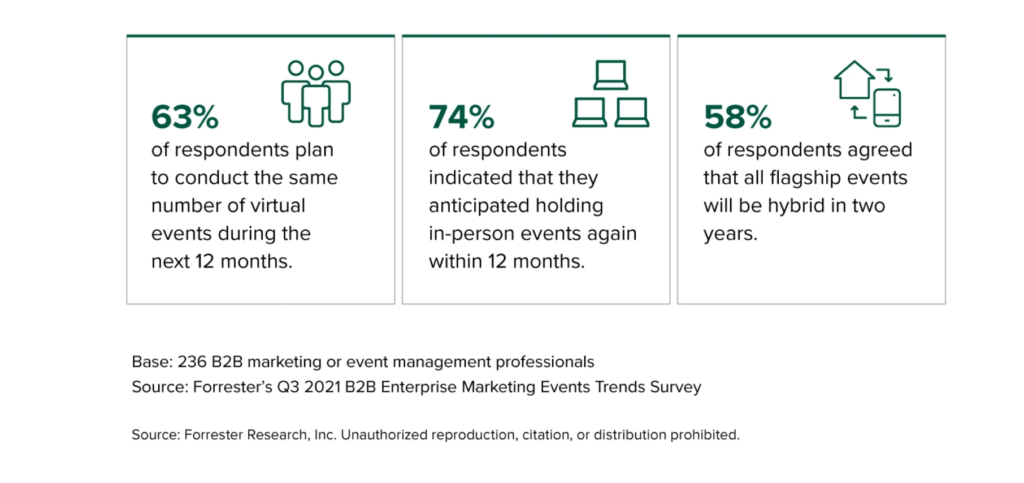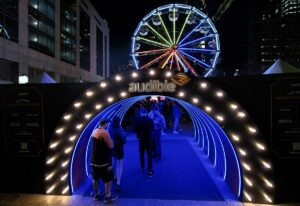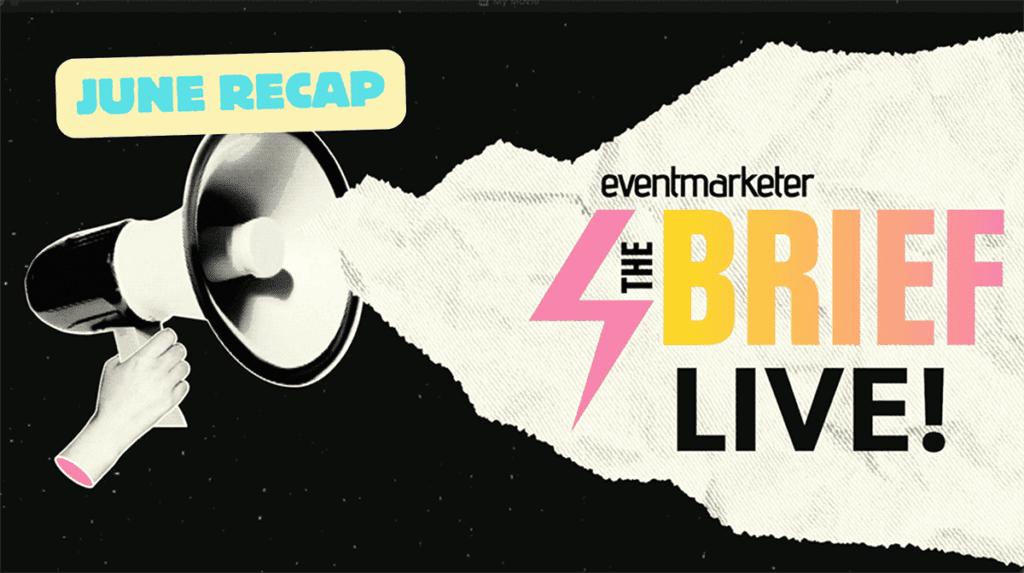Over the past 24 months, virtual events—and, more recently, hybrid formats—have proven crucial alternatives to in-person engagement during a time of unprecedented global disruption. And despite the resurgence of in-person events, it appears that these adaptations will become permanent fixtures within the event marketing discipline. Case in point: 63 percent of B2B decision-makers surveyed in Forrester’s Q3 2021 B2B Enterprise Marketing Events Trends report anticipate conducting the same number of virtual events—or more—during the next 12 months.
But when considering whether to use virtual or hybrid formats, marketers should not only consider specific audience objectives but also the various stages of the buyer’s journey and the event types that are most conducive to delivering on those business goals.
“As buyers go through a purchase process, at the start they’re looking to educate themselves. Then they’re looking at possible solutions, and then there’s the selection stage,” Forrester Principal Analyst Conrad Mills said. “The buyers that we survey are asked to choose from about 40 different interactions, a number of which are event interactions, and we can see that the different event types play much more strongly at different stages of the buyer’s journey.”
More specifically, when buyers are starting out the purchase journey, educational, content-rich virtual events are the most impactful event type, according to additional data gathered by Forrester from its 2021 B2B Buying Survey. For the evaluation stage, in-person trade shows, forums or seminars are favored, as buyers seek more face-to-face interaction. And when it comes to transitioning to the commit stage of the buyer journey, customers seek smaller, more discussion-oriented events, especially vendor-hosted online forums and in-person executive briefings.
Virtual is now a permanent fixture within the event marketing mix, according to buyers interviewed by Forrester. And at the discovery stage in particular, the percentage of buyers who find virtual events impactful grew from 23 percent in 2019 to 27 percent in 2021. Moreover, hybrid events are most likely to take place during flagship B2B events, the data showed, with 58 percent of marketers agreeing that all flagship events will be hybrid in two years.
“But in-person needs to be different when it comes back,” according to Mills. “Hybrid will be the defacto standard for flagship business-to-business events moving forward. [Clients] weren’t thinking about it just as a stop gap for this year in case COVID came back and they had the virtual fallback. The people that I consider leaders in the business-to-business events space were talking about this as a mid- and long-term strategy for flagship.”
Following is an excerpt of our conversation with Mills about how marketers can approach B2B events in the coming year, new trends in the industry, the rise of regional-level decision-making around events, and more.
Chief Marketer: How should B2B marketers be thinking about using specific event types at different stages of the buyer journey?
Forrester Principal Analyst Conrad Mills: We go out to around a thousand business-to-business buyers globally and ask them what type of marketing interactions have been most impactful at the different stages of the buyer’s journey. As they’re going through a purchase process, at the start they’re looking to educate themselves. Then they’re looking at possible solutions. And then there’s the selection stage, and we can see where they’re different.
The buyers that we survey are asked to choose from around 40 different interactions, a number of which are event interactions. We can see that the different event types play much more strongly at different stages of the buyer’s journey. So that is one of the starting points. Think about the audience that you are targeting, where they are in their buyer’s journey, and what type of event interaction is best going to help them think about the objectives that you set for the event. And then, determine the event type.
CM: The study showed that marketers still face challenges with implementing event technology. What effect is this having on the marketing industry?
Mills: Around half of the people we surveyed had still not integrated their marketing event technology with a wider marketing ecosystem. The data also showed that one of the key benefits of virtual events has been the ability to capture data and insights, but unless you’re able to move that quickly and seamlessly from your event tech platform into your map and your CRM, it’s not delivering the value to your organization that it could.
You need to be using technology in a way that facilitates the attendee experience. You can’t just be throwing technology at an event for the sake of it. You need to think very carefully about the experience that you want to craft.
CM: What are some of the new trends you’re seeing in events?
Mills: There is greater regional-level decision-making authority around events at the moment. Because of the different waves of COVID, where they’ve been hitting at different points in time, organizations generally are giving greater local-level autonomy to make decisions around events than they did pre-pandemic. And we’re seeing different types of events now as well, smaller, locally-driven roadshow-type events. There’s been a change in the actual event type and connected to that, more regional decision-making authority.
One of the big trends and themes for me—and I’ve just done some new primary research on this and the findings will be coming out in the next few weeks—is the whole area of environmental sustainability. It’s been there for a while, but we’re seeing, not just within the event space, but across the board, that it’s come back as a really strong theme this year. There’s some separate Forrester data where we found that 63 percent of professionals had identified improving environmental sustainability as a high or critical business priority for their organizations. And in the enterprise marketing event survey that I did last year, just over a third of the people that responded to that actually called out the low carbon footprint as a key benefit of virtual events.
But I think organizations need to think about it at two levels. Firstly, at the event selection level. So, building a mix that incorporates virtual, hybrid and in-person, because the footprint of virtual and hybrid is lower than in-person. But as in-person comes back, it’s about paying much more attention to environmental sustainability. There is legislation coming in Europe and North America as well around environmental reporting in 2023, and things like that could have an impact. It’s not new, but I’m seeing it as a much stronger theme this year. In general, organizations are paying much more attention to it, and I think that will have an increasing impact on the event space for the next 12 to 18 months.




 Network
Network

